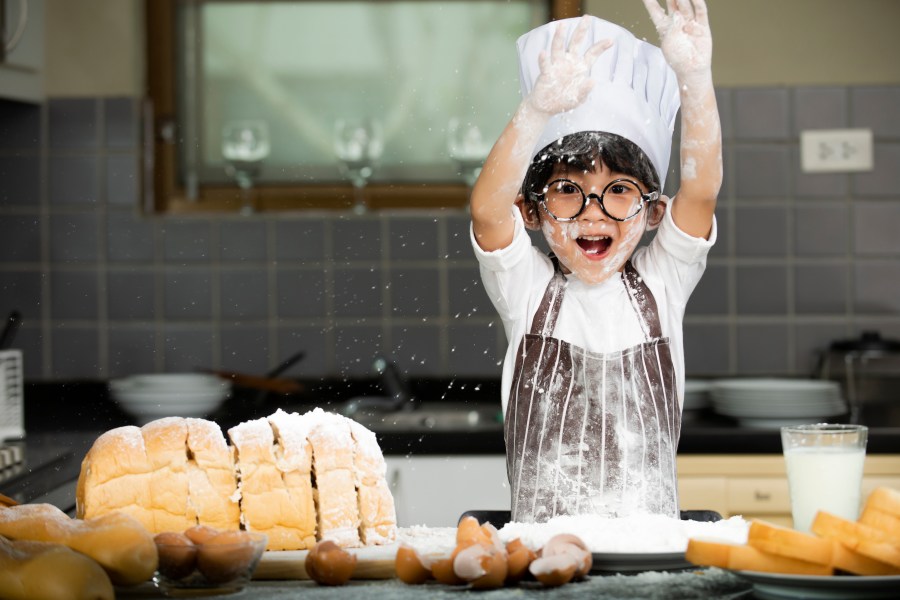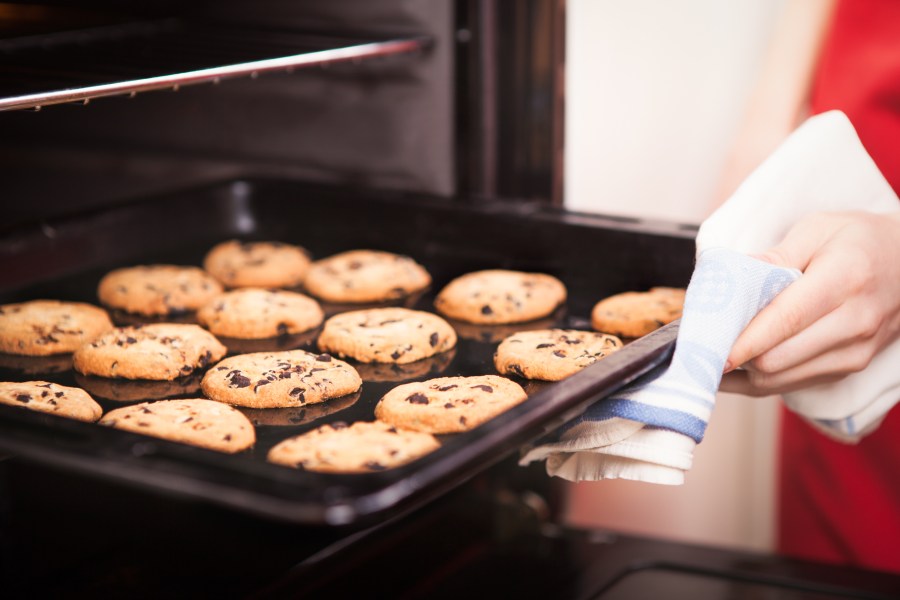Tampa (BLOOM) – Baking can seem daunting for beginners, but fear not! With the right tools, techniques, and a bit of practice, you can become a baking pro in no time. In this article, we’ll approach the basics of baking. So, let’s dive in and start mastering the art of baking!

Essential Baking Tools and Equipment
Before we start baking, we need to make sure we have the necessary tools and equipment. Here are the essentials:
- Measuring cups and spoons: Accurate measurements are critical in baking, so it’s important to use proper measuring tools. When measuring dry ingredients like flour and sugar, it’s important to level off the top with a knife or spatula to ensure the correct amount is used. Liquid ingredients should be measured at eye level for accuracy.
- Mixing bowls: The material of the bowl can affect the outcome of the recipe. Metal bowls are great for conducting heat and are good for whipping egg whites and cream. Glass bowls are great for mixing, but not ideal for whipping ingredients. Plastic bowls are lightweight and easy to handle, but may retain flavors and odors.
- Whisk or electric mixer: A whisk is used for mixing and incorporating air into ingredients like egg whites or cream. An electric mixer is essential for recipes that require creaming, like cookies or cakes. Stand mixers are great for larger batches, while handheld mixers are good for smaller quantities.
- Spatula: A spatula is a versatile tool for baking. It can be used to scrape bowls, fold ingredients together, and spread batter evenly in a pan. Silicone spatulas are heat-resistant and won’t scratch non-stick pans.
- Baking pans: Different recipes require different types of baking pans. For example, a muffin pan is used for muffins and cupcakes, while a cake pan is used for cakes. Non-stick pans are great for delicate baked goods, while cast iron is good for bread.
- Oven thermometer: An oven thermometer is important for ensuring the correct temperature. Most ovens have a temperature variance of up to 25°F, so it’s important to use a thermometer to ensure the oven is at the correct temperature.
- Cooling rack: A cooling rack is essential for allowing baked goods to cool evenly and prevent condensation from forming on the bottom of the pan. It also allows air to circulate around the baked goods, which helps prevent them from becoming soggy.
Understanding Baking Ingredients
The quality of the ingredients you use can greatly affect the outcome of your baked goods. Always opt for high-quality ingredients whenever possible. Here are some commonly used ingredients and their functions:
- Flour: All-purpose flour is the most commonly used flour in baking, while bread flour has a higher protein content and is ideal for yeast breads. Cake flour is low in protein and produces a tender crumb, while whole wheat flour is higher in fiber and produces a denser texture. Self-rising flour contains baking powder and salt, and is often used in southern-style recipes like biscuits.
- Sugar: Granulated sugar is the most common sugar used in baking, while brown sugar adds moisture and a caramel flavor. Powdered sugar is used for making frosting and icing, while coarse sugar is used for decorating and adding texture.
- Leavening agents: Baking powder and baking soda are both leavening agents used to make baked goods rise. Baking powder is a combination of baking soda, cream of tartar, and cornstarch, while baking soda is pure sodium bicarbonate. It’s important to use the correct amount of leavening agent to ensure the proper rise.
- Fats: Butter, margarine, oil, and shortening are all used as fats in baking. Butter adds flavor and moisture, while margarine is often used as a substitute for butter. Oil produces a moist texture and is often used in recipes that require a liquid fat. Shortening produces a tender crumb and is often used in recipes like pie crusts.
- Dairy: Milk, cream, and buttermilk are all used in baking. Milk is often used to create a lighter texture in baked goods, while cream adds richness and flavor. Buttermilk is often used in recipes that require an acidic ingredient, like biscuits and pancakes.
- Eggs: Eggs are used to provide structure and moisture in baked goods.
Don’t forget to measure your ingredients properly. Too much or too little of an ingredient can greatly affect the outcome of your baked goods.
Baking Techniques and Terminologies
There are many mixing methods in baking, and each one has a purpose. Here are some common techniques:
- Creaming – beating butter and sugar together to incorporate air
- Folding – gently mixing ingredients together without deflating the mixture
- Beating – vigorously mixing ingredients to incorporate air
Understanding baking terminologies is also important. Here are some commonly used terms:
- Preheat – warming up the oven before baking
- Bake – cooking food in the oven using dry heat
- Broil – cooking food using direct heat from the top of the oven
Basic Baking Recipes

Now that we have the tools, ingredients, and techniques down, it’s time to start baking! Here are some simple and easy-to-follow recipes for beginners:
Chocolate Chip Cookies:
Ingredients:
- 2 1/4 cups all-purpose flour
- 1 tsp baking soda
- 1 tsp salt
- 1 cup unsalted butter, softened
- 3/4 cup white sugar
- 3/4 cup brown sugar
- 2 large eggs
- 2 tsp vanilla extract
- 2 cups semisweet chocolate chips
Instructions:
- Preheat the oven to 375°F (190°C) and line a baking sheet with parchment paper.
- In a medium bowl, whisk together the flour, baking soda, and salt.
- In a large bowl, cream together the butter, white sugar, and brown sugar until light and fluffy.
- Add the eggs and vanilla extract to the butter mixture and beat until well combined.
- Gradually stir in the flour mixture until just combined.
- Fold in the chocolate chips.
- Using a cookie scoop or spoon, drop rounded balls of dough onto the prepared baking sheet.
- Bake for 8-10 minutes or until the edges are lightly golden.
- Allow the cookies to cool on the baking sheet for 5 minutes before transferring them to a wire rack to cool completely.
Vanilla Cupcakes:
Ingredients:
- 1 1/2 cups all-purpose flour
- 1 tsp baking powder
- 1/2 tsp baking soda
- 1/4 tsp salt
- 1/2 cup unsalted butter, softened
- 1 cup white sugar
- 2 large eggs
- 2 tsp vanilla extract
- 3/4 cup milk
Instructions:
- Preheat the oven to 350°F (175°C) and line a cupcake tin with paper liners.
- In a medium bowl, whisk together the flour, baking powder, baking soda, and salt.
- In a large bowl, cream together the butter and sugar until light and fluffy.
- Add the eggs and vanilla extract to the butter mixture and beat until well combined.
- Gradually stir in the flour mixture, alternating with the milk, until just combined.
- Using a spoon or scoop, divide the batter evenly among the prepared cupcake liners.
- Bake for 18-20 minutes or until a toothpick inserted into the center of a cupcake comes out clean.
- Allow the cupcakes to cool in the pan for 5 minutes before transferring them to a wire rack to cool completely.
- Once the cupcakes are completely cool, frost them with your favorite frosting and enjoy!
Follow the instructions carefully, and don’t be afraid to experiment with flavors and textures.
Troubleshooting Baking Problems
Even the most experienced bakers encounter problems from time to time. Here are some common baking problems and their solutions:
- Burnt bottoms – try placing a baking sheet underneath the pan
- Uneven rising – make sure the baking powder or baking soda is not expired
- Soggy or dense texture – make sure you’re using the right amount of ingredients and following the instructions carefully
Remember, practice makes perfect! Don’t be discouraged if your first attempt doesn’t turn out as expected. Keep practicing and experimenting until you get the hang of it.
Learning the basics of baking is a fun and rewarding experience. With the right tools, techniques, and ingredients, you can create delicious baked goods that will impress your family and friends. Keep experimenting and don’t be afraid to try new things. Happy baking!







